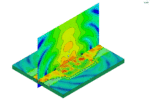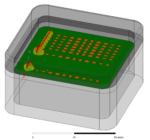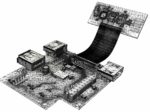I would contend there is no job quite like working as a support engineer for a simulation tool like Ansys HFSS. Such a role forces an engineer to understand technology in breadth and depth like no other because HFSS is applied to such a broad range of applications and products throughout the world. My own introduction to HFSS began … Read More
Bouncing off the Walls – How Real-Time Radar is Accelerating the Development of Autonomous Vehicles
In the race to get people out of the driver’s seat, the developers of autonomous vehicles (AV) and advanced driving assistance systems (ADAS) have gone off road and into the virtual world.
Using simulation to design, train and validate the brains behind self-driving cars — the neural networks of sensors and systems that perceive… Read More
The Electromagnetic Solution Buyer’s Guide
So you’ve decided to buy a new car? First you need to research, compare, and test drive before you finally get to drive that shiny new car home. Engineering teams choosing their preferred electromagnetic analysis tool face similar challenges. Historically, electromagnetic problems and analysis tools were relegated to a few … Read More
Electromagnetic and Circuit RLCK Extraction and Simulation for Advanced Silicon, Interposers and Package Designs
For years, there have been rather distinct domains for the extraction of interconnect models from physical design data.
Chip designers commonly focused on RC parasitics for circuit/path delay calculations and dynamic I*R voltage drop analysis. The annotation of extracted parasitics to a netlist model required the layout… Read More
Need Electromagnetic Simulations for ICs?
Electromagnetic (EM) simulations have been performed on die metal structures since the 1990s. Originally, the analysis was restricted to a single device (e.g., a spiral inductor). The number of on-die devices simulated simultaneously grew with the increasing capabilities of the computers performing the computations. This… Read More
Webinar: Electrothermal Signoff for 2.5D and 3D IC Systems
The move from single-chip design to system-in-package design has created many challenges. The rise of 2.5D and 3D technology has set the stage for this. Beyond the modeling requirements and the need for ecosystem collaboration to get those models, there is a significant challenge in understanding the data. The only way to truly… Read More
Best Practices are Much Better with Ansys Cloud and HFSS
Compute environments have advanced significantly over the past several years. Microprocessors have gotten faster by including more cores, available RAM has increased significantly, and the cloud has made massive distributed computing more easily and cheaply available.
HFSS has evolved to take advantage of these new capabilities,… Read More
System-level Electromagnetic Coupling Analysis is now possible, and necessary
With the increasing density of electronics in product enclosures, combined with a broad range of operating frequencies, designers must be cognizant of the issues associated with the radiation and coupling of electromagnetic energy. The interference between different elements of the design may result in coupling noise-induced… Read More
HFSS – A History of Electromagnetic Simulation Innovation
In the 155 years since James Clerk Maxwell introduced the world to Maxwell’s Equations in the “Dynamic Theory of the Electromagnetic Field” there have been some amazing breakthroughs and avenues of insight. As a young electrical engineering student, we are introduced to the set of equations describing electromagnetic waves,… Read More
HFSS Performance for “Almost Free”
Everyday, engineers are running simulations to deliver the next generation of products to make our lives better. Everyday, they wait for those simulations to finish, wishing that they could get answers instantaneously. While waiting for those simulations or checking on the status of their runs at night, they might indulge in… Read More










